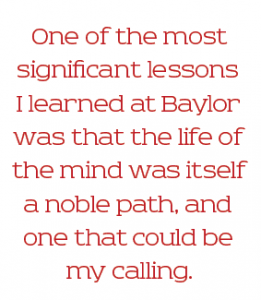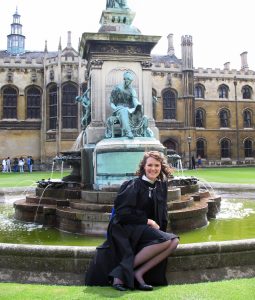Dr. Jamie A. Gianoutsos (BA ’06) is an assistant professor of history at Mount St. Mary’s University in Emmitsburg, Maryland. As a Baylor undergraduate, Gianoutsos was one of a select group of American students to win a Marshall Scholarship to pursue graduate studies in Britain. She went on to complete a PhD in history at Johns Hopkins University, and in her current role as director of competitive fellowships at Mount St. Mary’s she works closely with students as they prepare applications for the Marshall and other prestigious international scholarships and fellowships. In this First Person essay, Gianoutsos reflects on the value that engaged learning has played in her career and personal life.
———————–
Three Irish fairies live in the honey locust tree outside my five-year old son’s window. They’re not your usual fairies, birthed from a Disney tale or animated American classic. These hail from a small hillside outside Waterford, where I first encountered them four months after moving to Belfast to pursue a master’s degree in Renaissance literature. My new friend, Siobhan, a graduate student of social anthropology also at Queen’s University in Belfast, had invited me to her parents’ home in Ireland to have an authentic experience of Irish culture and cooking. The tour of the city and surrounding countryside of Waterford, expertly offered by Siobhan’s father, included the cold Ardmore seaside, a graveyard of saints, a 700-year old Anglo-Norman tower, and the rugged landscape of Mahon Falls –– about which Siobhan’s father explained, “Girls, our mountains are very, very old. That’s why they’re not very tall.” It was near the falls that we were introduced to the fairy tree and its accompanying optical illusion: cars put into neutral next to the squat, knobby tree appeared to roll upwards rather than down. Clear evidence that this was no ordinary tree.
As my five-year old would tell you, these same Irish fairies moved to the tree outside his window before he was born, when I returned to the United States after having lived in the United Kingdom for two years. They hid away in my luggage, and when these fairies feel homesick for the Emerald Isle, they conjure a beautiful rainbow to guide them home again. Tall tales spun from Irish inspiration have fueled childhood wonder and learning for my children, and for me, an opportunity to indulge in nostalgia for the people, places, and hospitality that transformed my own learning and widened my imagination. Fairy trees perhaps fit oddly with refined definitions of academic engaged learning, but I would argue that they capture a central element of study –– that of wonder and openness to the unexpected.
Thankfully, I did not have to stow away in someone’s luggage to cross the Atlantic Ocean to Northern Ireland. My ticket was purchased through a Marshall Scholarship, a highly distinguished scholarship program that funds two to three years of graduate education in the United Kingdom. During my time there, I completed two master’s degrees, the first at Queen’s University, and the second at the University of Cambridge in political thought and intellectual history. My summer in between these programs was spent researching in Oxford, and visiting with the professors and students studying abroad for the Baylor in Oxford program.
Over these two years, the Marshall Scholarship introduced me to the rolling landscapes of Ireland and the Tudor spires of Oxbridge. It also let me roam freely and read deeply through the pamphlets, treatises, plays and poems of the 16th and 17th century. Leisure, classically conceived, lies at the heart of the Marshall experience –– the leisure to study, to explore, to think, to compose.
A liberal arts education is intended to be just that –– leisured and free –– and I was deeply fortunate that Baylor had already offered me such an interdisciplinary education in historical ideas, fostered in intimate classroom discussions and nourished through research projects and extracurricular programming. I had originally entered Baylor as a political science major, bent upon a path of law school or running for public office. I eagerly took college courses on constitutional law and the history of political thought, with the plan of interning in a political office in Washington D.C.
 This was a noble plan, but one I found particularly difficult to pursue as a young woman with few financial means. How could I afford to take an unpaid internship? Where would I find the means to live in D.C? At the same time, I encountered an intellectual hindrance as well, as I discovered that my passion for the political lay in the theory of politics rather than its practice. One of the most significant lessons I learned at Baylor was that the life of the mind was itself a noble path, and one that could be my calling.
This was a noble plan, but one I found particularly difficult to pursue as a young woman with few financial means. How could I afford to take an unpaid internship? Where would I find the means to live in D.C? At the same time, I encountered an intellectual hindrance as well, as I discovered that my passion for the political lay in the theory of politics rather than its practice. One of the most significant lessons I learned at Baylor was that the life of the mind was itself a noble path, and one that could be my calling.
After adding Great Texts of the Western Tradition as a second major to political science, my Baylor coursework became a rich interdisciplinary study of the ideas, politics and cultures of the past. Much like Machiavelli’s description of study in his famous letter to a friend, my professors taught me how to enter into the courts of the ancients and be received by them as a friend –– to converse with them and probe the reasons for their actions.
In particular, my studies made me enchanted with what we refer to as “early modern” Europe, that period of time between the medieval and modern, where individuals in Italy, England, France and Spain experienced Renaissance, civil war and Enlightenment. One afternoon, walking near Pat Neff Hall, I remember running into two of my professors teaching the early modern world, Dwight Allman and Robert Miner. I asked them if there could possibly be a more interesting and exciting period in history than this one –– complete with Protestant reformation, the “new science,” the printing press, Machiavelli’s political philosophy, Shakespeare’s plays, the beheading of kings and modern revolution –– or a period in time that better explained our own.
Baylor gave me this intellectual awakening. My professors not only instilled in me the wonder and intellectual curiosity necessary for engaged learning, but afforded me avenues to write and to publish, to present my ideas, and to join and form campus clubs such as a new medieval literary society. The Carr P. Collins Scholarship I received, which had played a significant role in bringing me to Baylor, also challenged me not just to study communities but also to serve them every week with my own hands.
Applying for the Marshall Scholarship required wordsmithing and soul-searching well beyond what I had experienced prior, and was itself a learning process I underwent through the deft and compassionate direction of Elizabeth Vardaman, associate dean for engaged learning in the College of Arts & Sciences, who gently but firmly told me to write and rewrite again. Dean Vardaman taught me much more than the technical aspects of application writing. She encouraged me to hear and to appreciate the beauty of language; in the afternoons, reading poems such as Seamus Heaney’s “The Turnip-Snedder” aloud to me, she helped prepare me for foreign soil.
Now, close to 15 years later, I walk across the quad of Mount Saint Mary’s University and gratefully encounter students abuzz with the thoughts of the ancients and early moderns. At this liberal arts university, which is the second-oldest Catholic university in America, I teach courses on the great texts, ideas, people and cultures of the European past, with a special focus on early modern Britain. I encourage my students not only to learn the skills necessary for their future professional lives, but also to spend their university days falling in love with a subject and practicing the posture of wonder, openness and enthusiasm necessary to pursue lifelong learning.
My office at the university is filled to the brim with antique maps, trinkets from European travel, postcards from faraway friends and pictures of my Baylor-sweetheart-now-husband, who had initially proposed marriage to me while driving in the Irish countryside. The office holds my memories, but my daily work, within and outside of the classroom, serves as the true memorial of these great gifts I have received.
Recognizing an unmet need at Mount Saint Mary’s, I established the Office of Competitive Fellowships in order to mentor students through scholarship applications. I seek not only to help students win opportunities such as the Marshall, but to help provide them the compassionate guidance and challenging opportunities of engaged learning necessary for them to flourish. Watching these students travel to Bristol, to Mexico and even to Belfast to pursue service and study, I have become eager to see the fairy trees they will transplant from their own adventures abroad, and to see the original investment that Baylor made in me continue to bear fruit in the lives of others.
———————–
Top photo by Greg Kahn


